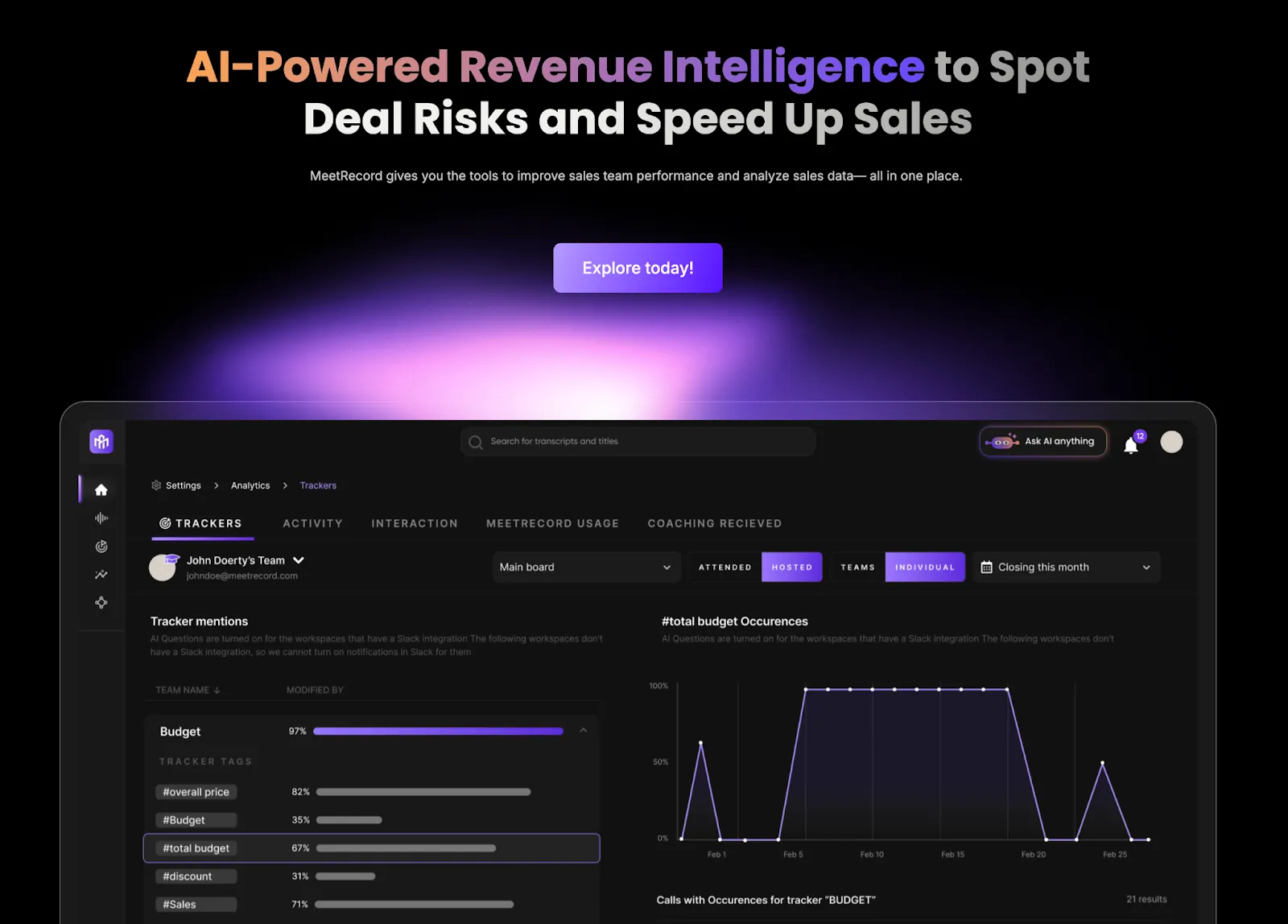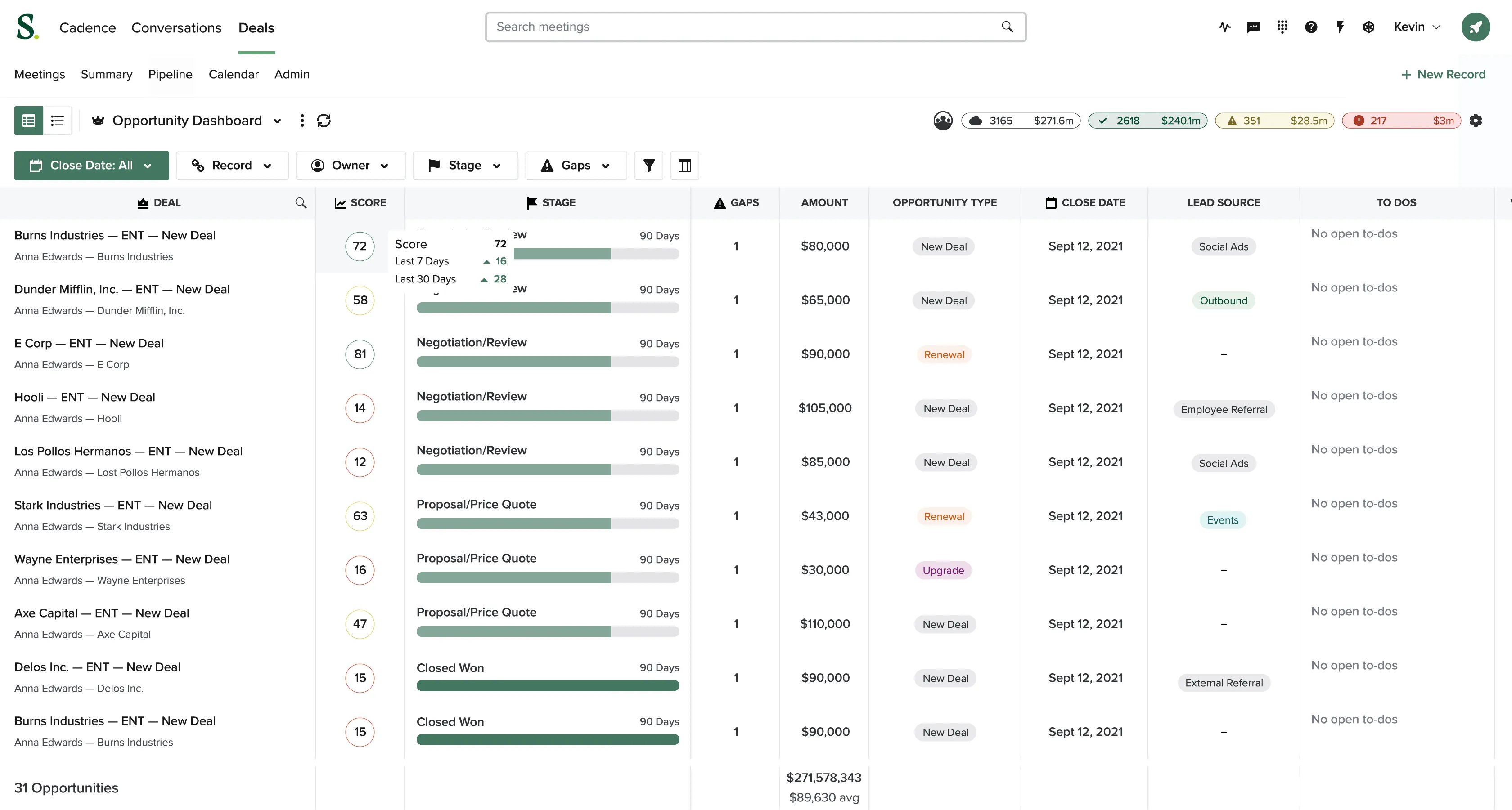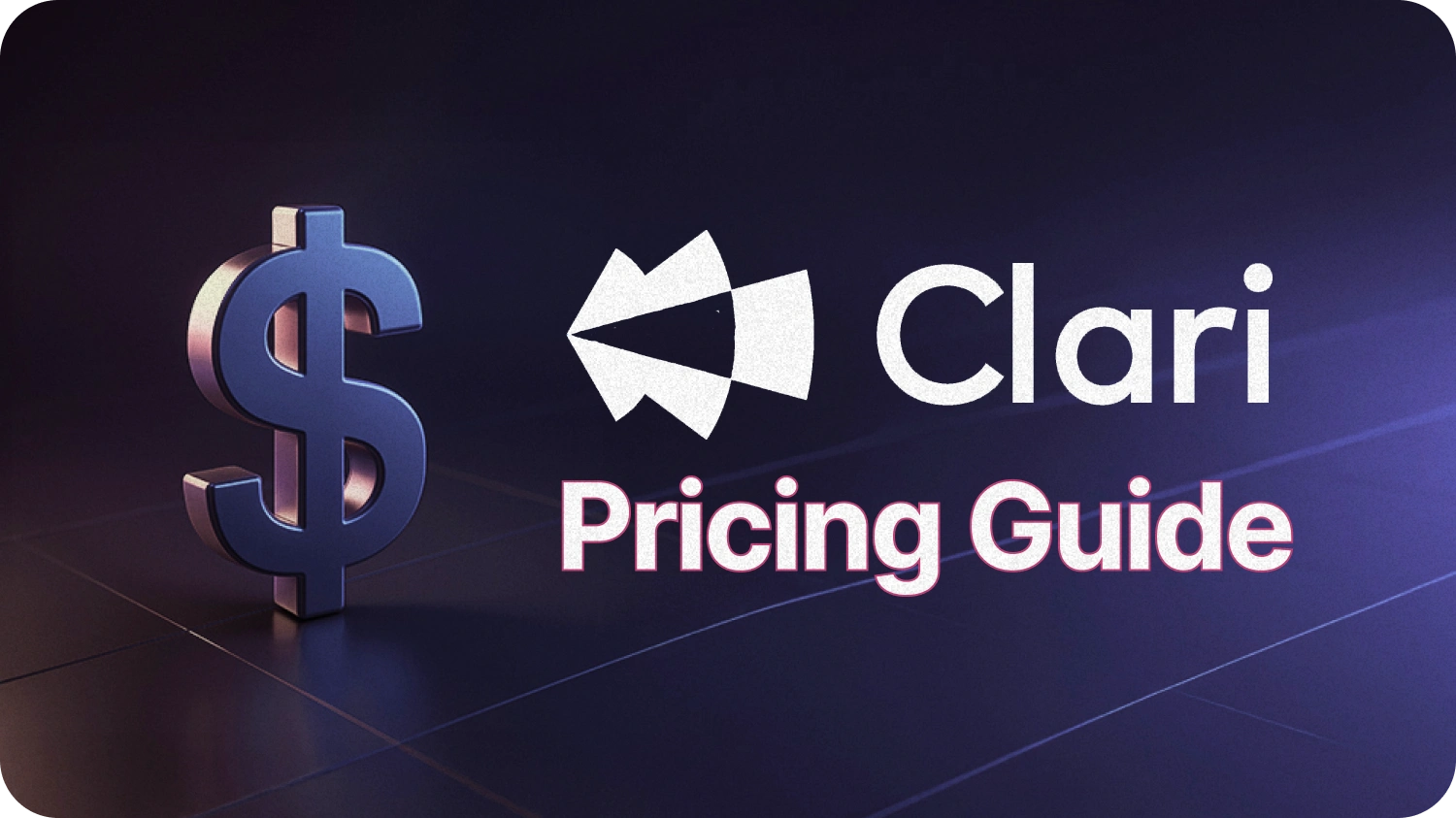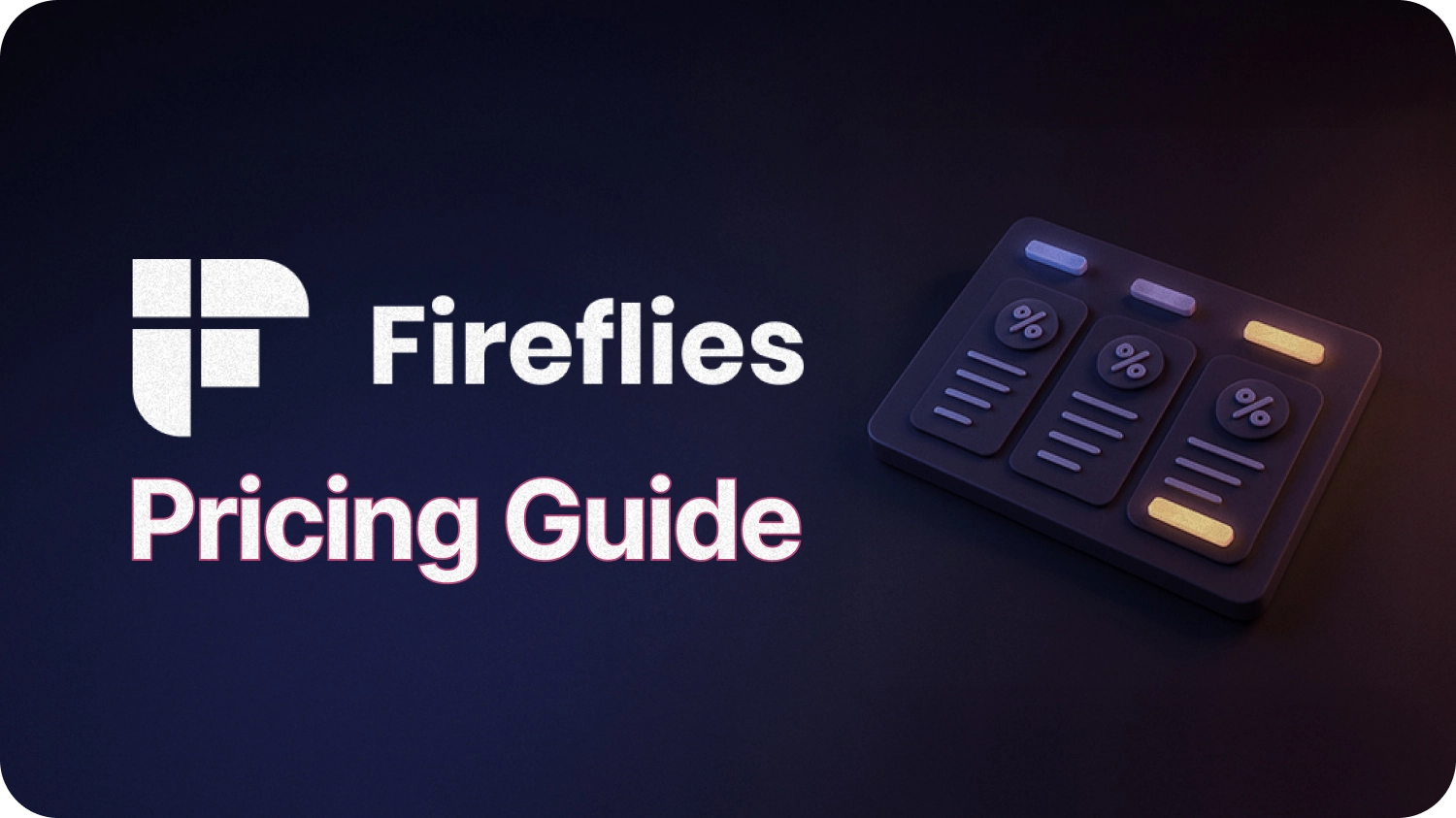There’s no doubt that Gong.io is a pioneer in the conversation and revenue intelligence space. Its platform captures sales calls, analyzes customer interactions, and provides AI-driven insights that sales teams love. However, if you’re reading this, you’re likely trying to figure out Gong’s pricing (it isn’t publicly listed) or exploring Gong alternatives that might fit your budget and needs better.
For scaling sales teams and RevOps leaders, pricing and ROI are critical. Gong’s lack of transparent pricing makes it challenging to plan budgets and justify the investment. In this post, we’ll clear up the confusion around Gong’s pricing in 2025 and compare it with four alternative conversation intelligence tools. We’ll look at up-to-date pricing, key features, contract terms, and ROI factors for: MeetRecord, Chorus.ai, Salesloft, Fireflies.ai (and we’ll briefly mention Avoma and Jiminny as other notable options). Our goal is to help you make an informed decision that balances innovation with affordability.
Before diving into each tool, let’s start with a snapshot of Gong’s pricing.
Gong Pricing (Updated June 2025)
Gong does not publicly list prices, but based on industry sources and proposals, here’s an overview of Gong.io’s pricing structure in 2025:
Source: Proposals
What Gong Costs for Small, Mid-Market, and Enterprise Teams?
1. Small Teams (10–50 Sales Reps)
Gong’s pricing can be steep for small teams. With $1,200–$1,600 per user annually plus a $5,000 platform fee, a 10-person team is looking at ~$17,000 before onboarding. That climbs to $85,000 for 50 users, and adding the $7,500 onboarding fee pushes totals even higher. For lean teams, this level of spend may not match current needs, making lighter tools like Fireflies or Avoma more cost-effective options.
2. Mid-Market Teams (50–250 Sales Reps)
Mid-sized orgs feel the pricing pinch most. A 250-rep team could pay $300K–$400K per year in license fees alone. Add Gong’s platform and onboarding costs, and the first-year spend hits $312K - $412K. With contracts often locked in for 2–3 years, many teams negotiate aggressively using timing, competition, and budget constraints to reduce long-term commitments.
3. Enterprise Teams (250+ Sales Reps)
At the enterprise level, Gong spend can reach $500K–$800K+ annually, especially when layering in modules like Forecast or Engage. But big accounts also have leverage. Gong frequently offers deep discounts, custom onboarding, or waived platform fees to win large deals. Savvy procurement teams often explore mix-and-match strategies with competitors to optimize cost and coverage.
Here's a quick overview of Gong's pricing across teams:
How Gong’s Customers Really Feel About its Pricing
Gong’s pricing structure can vary significantly based on negotiation skills, timing, and growth potential. To give you an insider perspective, here are some real quotes from actual Gong customers and revenue leaders across various company sizes who recently negotiated Gong pricing, sourced via Vendr:
1. On Hidden Costs and Platform Fees:
2. On Bundled Product Constraints:
3. On Pricing Flexibility:
4. On Reductions and Limited Discounts:
5. On Reduced Functionality (Gong Lite):
Here’s a snapshot of pricing quotes and feedback shared by Gong’s customers on Reddit



Source:
2. r/sales
In plain terms, Gong pricing is roughly $1,200–$1,600 per user per year (billed annually) plus a mandatory platform subscription fee of $5,000. For example, a small team of 10 users would pay about $21,000 per year (10 × $1,600 + $5,000 base) just for licenses. On top of that, Gong typically charges a one-time onboarding and training fee of $7,500 for professional services. And keep in mind, Gong often requires a multi-year contract (commonly 3 years up front) with no month-to-month option.
Hidden Complexities in Gong.io Pricing You Should Know
When evaluating Gong, it’s crucial to understand some nuanced aspects that significantly impact your total investment. Here's what Gong users have recently experienced, based on industry insights:
1. The Hidden Costs of "Platform Fees"
Gong typically adds a significant annual "platform subscription fee," commonly set around $5,000–$10,000 annually. While this might sometimes be negotiable or waivable, it's frequently charged unless strongly contested. Customers who aren't proactive can easily find this fee embedded in their contract, raising their total costs substantially.
Customer Quote:
"Initially, our Gong renewal included a $10,000 platform fee, which only got waived after multiple rounds of negotiation citing tight budget constraints."
(Company with 201–1000 employees) - Source : Vendr Community
For smaller sales organizations or those without dedicated procurement teams, such hidden fees can dramatically skew budgets, especially since Gong’s standard negotiation cycle can be challenging and opaque.
2. Gong Engage: A Double-Edged Sword
Gong Engage is Gong’s additional sales engagement product. However, there's an important catch: Gong Engage licenses cannot be purchased separately. To use Gong Engage, companies must also buy Gong’s core licenses, which effectively doubles your investment.
This bundling requirement often results in organizations paying for licenses or features they don’t fully utilize, significantly inflating annual spending. It also restricts flexibility, forcing you into a heavier investment than you might initially plan.
Customer Quote:
"We wanted Gong Engage, but Gong required us to purchase a Gong Core license for every Gong Engage seat. This forced bundling substantially increased our total cost beyond our original budget."
Source : Vendr Community
This bundling approach limits your ability to scale efficiently, especially when budgets or headcount fluctuate during uncertain growth periods.
3. Gong Lite: A Lower-Cost Compromise?
Recently, Gong introduced Gong Lite, a stripped-down, more affordable variant aimed at companies experiencing significant price pushback. Gong Lite attempts to retain customers who find Gong's standard pricing too steep.
But here’s the critical question: what essential capabilities are missing from Gong Lite? Customers forced onto this plan often sacrifice significant functionality in coaching insights, detailed analytics, and predictive deal intelligence, precisely the features that justified using Gong initially.
Customer Quote:
"Due to internal budget pressures, Gong offered Gong Lite as an alternative to our regular plan, but we quickly realized it lacked many advanced analytics and coaching features essential for our team."
Source : Vendr Community
This means that opting for Gong Lite often puts companies in a difficult position to accept reduced functionality, or remain tied to Gong's expensive standard plans.
While Gong is the market leader and offers a very robust platform, this level of spend might not make sense for every organization. The good news: there are several Gong alternatives in 2025 that deliver comparable conversation intelligence features at a fraction of the cost. The key is finding a tool that balances powerful capabilities with pricing and flexibility that align to your business.
If Gong’s pricing is a bit “loud” for your budget, you’re not alone. Many revenue teams, especially at startups and growth-stage companies, are seeking more cost-effective options that still drive results. Next, we’ll explore four top alternatives to Gong – including what they cost in 2025, what they do best, and how their contracts work, so you can evaluate which fits your needs.
Top Gong Alternatives (with 2025 Pricing & Features)
To set the stage, here’s a quick comparison of Gong and four alternative revenue intelligence tools on key pricing and contract points:
Notes: All prices are as of 2025 and may vary based on negotiations, enterprise packages, or add-ons. Per-user costs assume annual billing unless noted.
As shown above, alternatives like MeetRecord, Fireflies, and Chorus.ai can come at significantly lower per-user costs than Gong. Most have no hefty platform fee and free or low-cost onboarding, which alone can save $5K–$12K upfront. Several also offer monthly billing or shorter contract terms, whereas Gong typically locks you into a large annual (or multi-year) commitment. Next, we’ll dive deeper into each alternative and how they compare to Gong in use cases and value.
Now, let’s explore the top Gong alternatives in detail.
1. MeetRecord vs. Gong.io
MeetRecord is an AI-first revenue intelligence platform that offers almost everything Gong does – and then some – but with far more transparent pricing. It’s specifically geared toward high-growth companies and enterprises that need robust sales insights without the enterprise price tag.

Key Use Cases & Capabilities:
- Conversation Intelligence: Automatic call recording, transcription, and AI-generated call summaries provide full visibility into customer conversations.
- Advanced Sales Coaching: AI-driven call scoring and personalized coaching programs help managers upskill reps. MeetRecord even offers AI Sales Roleplays for training (simulate real sales calls for practice).
- Deal & Buyer Intelligence: Monitor deal health with real-time pipeline insights, identify buyer intent signals early, and uncover win/loss patterns to refine your sales strategy.
- CRM Automation: Auto-sync every call, summary, and deal update to your CRM eliminating manual data entry and ensuring data consistency.
- Collaboration & Customization: A searchable library of high-scoring call recordings makes it easy to share best-call examples. MeetRecord also supports customizations and white-labeling, so the platform can fit your branding and workflow needs.
One key thing Gong misses in its coaching suite is giving sales reps a way to actually practice before real calls. This is where MeetRecord steps in.
With built-in AI Sales Roleplay, reps can simulate real conversations . From cold calls to demos reps can practice using voice-cloned personas based on real buyers. It’s fully customizable, so your team can rehearse specific scenarios, build confidence, and sharpen their pitch.
You can try and experience it first hand here. 👇
Who's MeetRecord Ideal for:
- Scaling Sales Teams (SMB to Enterprise): Organizations from startups to large enterprises that want Gong-level insights but need a higher ROI and more flexible terms.
- ROI-Focused Leaders: Sales and RevOps leaders who are value-conscious – MeetRecord is designed to deliver 2.5×–6× ROI vs. Gong in many cases. It’s ideal if you must justify spend with clear returns.
Pricing :
MeetRecord uses a tailored pricing approach – you work with their team to get a quote that fits your usage (e.g. call volume, number of users). The big differences: there are no platform fees or hidden costs (Gong’s $5K + $7.5K fees = $0 here), and onboarding/setup is free. This immediately saves ~$12,500 compared to Gong. MeetRecord’s pricing is also flexible month-to-month – no multi-year lock-in, you can do annual or even quarterly terms as needed.
To give a sense of scale, depending on features and team size, MeetRecord will still be about 50%+ cheaper per seat than Gong’s average. Actual pricing may vary, but the key point is MeetRecord will cost dramatically less than Gong for a similar size team. And because there’s no big upfront fee, you can start small and scale as you see ROI. To get a customized quote specific to your business needs you can schedule a call here.
On the feature side, MeetRecord actually offers some capabilities Gong doesn’t yet have. For example, its built-in AI Sales roleplay simulator lets reps practice sales calls with an AI (great for coaching new hires), and its Buyer Intelligence module helps decipher buyer intent and engagement signals from your calls. MeetRecord’s focus on automation (like CRM syncing, AI-generated follow-up docs, etc.) means less busywork for your reps.
In short,with MeetRecord, you will get a comprehensive revenue intelligence solution, without the massive overhead. It’s a strong choice if you love Gong’s functionality but need to justify the investment or want more friendly terms. MeetRecord is also highly rated by users (e.g. 4.7 out of 5 stars on G2), indicating robust customer satisfaction. If budget and ROI are top of mind, MeetRecord is likely the first alternative to consider.
2. Chorus.ai vs. Gong.io
Chorus.ai (now part of ZoomInfo) is another leading conversation intelligence tool often compared to Gong. Chorus is known for its strong call recording/transcription quality and coaching insights. It’s a bit more narrowly focused on conversation analysis (whereas Gong pitches itself as broader revenue intelligence including deal pipeline).

Key Use Cases:
- Conversation Intelligence for Sales & CS: Chorus automatically records sales calls and virtual meetings, transcribes them, and uses AI to identify key topics (e.g. pricing discussions, next steps). Managers use it to review calls and coach reps on talk tracks and best practices. (It’s not limited to Sales – Customer Success and other client-facing teams can also use Chorus to glean insights, making it a broader use tool beyond just sales.)
- Team Coaching and Skill Development: Chorus provides analytics on rep behaviors (talk time, patience, filler words, etc.) and can highlight coachable moments. It aligns closely with improving sales call performance and ramping up new reps via call libraries and example moments.
- Market and Deal Intelligence: By analyzing many conversations, Chorus can surface market trends (e.g. common competitor mentions or product feedback) and deal risks. It’s positioned to help managers spot which deals might be in trouble based on call patterns, similar to Gong’s deal intelligence – though Gong’s forecasting features are more advanced.
Ideal for:
- Mid-sized to Large Sales Teams: Chorus tends to target medium and enterprise customers (it’s built into the ZoomInfo platform now). It works well for sales orgs that want conversation analytics but maybe don’t need all of Gong’s bells and whistles in pipeline forecasting.
- Teams Already Using ZoomInfo: If you’re a ZoomInfo customer, Chorus integrates natively. It can be ideal for teams that want their conversation intelligence tied in with ZoomInfo’s data and engagement tools. (It’s worth noting Chorus was an independent product, but since the acquisition, it complements ZoomInfo’s suite).
- Cost-Conscious Orgs Needing Core CI: Those who find Gong too pricey might consider Chorus as a “similar, but cheaper” alternative. It delivers the core conversation intelligence at a lower price point, albeit with a slightly less slick interface and less AI-driven deal guidance than Gong.
Chorus Pricing :
Chorus.ai is not fully transparent on pricing (you have to contact sales), but reports indicate it starts around $8,000 per year minimum, which includes 3 user seats. Additional seats are roughly $1,200 per user/year (about $100 per month). So, for example, a 10-person team would pay ~$16,400/year for Chorus. Contracts are typically annual (some deals are 2-year) but you might negotiate terms. The key point: Chorus doesn’t charge a separate platform fee like Gong does; the ~$8K serves as the base package. And there’s usually no extra onboarding fee – support and integrations are included in the subscription.
In practice, companies have noted Chorus comes out significantly cheaper than Gong for similar team sizes (often 30–50% less costly on license fees). One reason is ZoomInfo can bundle Chorus with other products or give volume discounts if you use more of their tools. If you’re price-shopping, you can leverage that in negotiations. Also, Chorus sometimes offers a short free trial (sales-assisted) to test it, whereas Gong does not – which is a nice way to evaluate before you buy.
Standout Features:
- High-Fidelity Transcription: Users often praise Chorus for having very accurate call transcriptions and speaker identification, which is crucial for analyzing calls. If your team values exact transcripts for compliance or training, Chorus is strong here.
- ZoomInfo Integration: Because it’s under ZoomInfo, Chorus data can tie into account/contact intelligence from ZoomInfo’s database. This could streamline your workflow if you rely on ZoomInfo for prospecting.
- Simplicity and Cost: Chorus delivers much of the same conversation insight value as Gong, but with a simpler pricing model (no huge upfront fees). It might lack some of Gong’s flashier AI features or forecasting, but it covers the essentials of call recording, keyword tracking, and coaching.
Bottom Line: Chorus.ai is a proven conversation intelligence platform that can be a budget-friendly alternative to Gong for many companies. You’ll get a powerful coaching tool for your sales calls, and you might save a substantial amount, especially if you’re already a ZoomInfo customer. Just be prepared to go through a quoting process, as Chorus’s pricing isn’t posted publicly either.
3. Salesloft vs. Gong.io
Salesloft is a bit different from the others on this list – it’s actually a Sales Engagement platform first, with some conversation intelligence capabilities baked in. Salesloft is widely used for managing sales outreach (email cadences, dialing, sequencing) and it added call recording/AI features to compete in the revenue intelligence space. If you’re considering Gong, Salesloft might come up as an alternative if you prefer an all-in-one solution for both engagement and conversation analysis.

Key Use Cases:
- Sales Engagement Automation: Salesloft is best known for its core tools like email cadence scheduling, automated dialer calls, voicemail drops, and cadence analytics. It helps SDRs/Account Executives manage their prospecting and follow-ups in a streamlined way.
- Pipeline and Deal Monitoring: Salesloft provides deal dashboards and basic deal intelligence signals (it can track email/call engagement in deals, helping identify risk). It’s not as specialized in deal analytics as Gong, but it gives a view of pipeline health and rep activity that managers find useful.
- Call Recording & Analysis: Within Salesloft’s platform, there is a feature (often called Salesloft Conversations) that records calls and meetings, transcribes them, and allows managers to coach reps. This is effectively Salesloft’s built-in Gong-like feature. It can flag keywords and topics, though it’s somewhat more limited in AI insights compared to standalone CI tools. The benefit is it’s integrated with the cadence tool – e.g., you can have one platform for both making the calls and analyzing them.
Ideal for:
- Sales Teams Wanting One Platform: If your team would prefer to minimize tools, Salesloft offers a one-stop shop: it handles outreach and provides conversation intelligence. This is ideal for companies that value convenience and integration over having the absolute best-of-breed in each category.
- Mid-Large Organizations: Salesloft is commonly used by medium to large sales teams. It’s robust and enterprise-ready. Small startups might find it too heavy if they only need call intelligence (in which case a lighter tool like Fireflies or Avoma could suffice).
- Teams Comparing to Outreach.io: Often Salesloft is evaluated alongside Outreach.io (another Sales engagement platform). Interestingly, Outreach itself doesn’t have as deep native Conversation Intelligence as Salesloft does with Conversations. If you’re leaning toward a sales engagement suite, Salesloft’s inclusion of conversation intelligence could sway you.
Salesloft Pricing:
Salesloft doesn’t publicly list pricing either – it’s quote-based, with packages (usually Prospect, Sell, Engage, or Enterprise tiers as of recent years). Based on various sources, Salesloft’s pricing ranges roughly from $125 to $165 per user per month for the full platform (Sell/Enterprise packages). That translates to about $1,500–$1,980 per user/year on an annual contract. There are also limited packages (for just cadencing or just one part of the platform) that can be lower – e.g. the Prospect or Engage packages might be ~$60–$100/user/month for limited features.
In addition to the license cost, Salesloft typically charges a one-time onboarding fee in the range of $3,000 (for training and implementation). This is much lower than Gong’s $7.5K services fee, but it’s still an extra cost to budget for. Contracts are annual only (no month-to-month), and some packages might require a minimum number of seats. On the plus side, Salesloft doesn’t have a separate “platform fee.” And if you only need certain modules (say just the cadencing and not the dialer), you might negotiate a lower price per seat.
To sum it: Salesloft can end up costing in the ballpark of Gong’s pricing for the fully loaded version, but you’re getting more than just conversation intelligence – you’re also paying for the sales engagement capabilities. If you were already budgeting for a cadence tool, consolidating with Salesloft might be efficient.
Standout Features:
- All-in-One Sales Platform: Salesloft’s biggest appeal is that it covers the whole sales development and coaching cycle. Reps can send emails, make calls, book meetings, and get those meetings recorded and analyzed, all in one system. This means less tool switching and a unified data view.
- Cadence and Automation Leader: As a sales engagement solution, Salesloft is top-tier. It orchestrates multi-touch cadences (emails, calls, LinkedIn, etc.) and logs everything to your CRM. If your priority is upping rep productivity in outreach, Salesloft shines there.
- Basic Conversation Intelligence Integrated: The conversation intelligence part (transcriptions, call insights) is decent and improving. It may not have as advanced AI recommendations as Gong/MeetRecord, but for many teams, having recordings, transcripts, and the ability to comment on calls is sufficient for coaching. Salesloft’s integration with Gong or Avoma is also something some teams do – interestingly, Salesloft can integrate with dedicated CI tools if you outgrow its native capabilities.
Bottom line: Salesloft isn’t a direct apples-to-apples alternative to Gong on its own, because it’s a broader platform. However, it’s absolutely an option to consider if you’re looking to both engage leads and analyze calls under one roof. If you have the budget, Salesloft can replace the need for Gong by offering “good enough” conversation intelligence alongside world-class sales engagement tools. Just be sure your team will leverage all parts of it; otherwise, you might pay a premium for features you don’t use.
4. Fireflies.ai vs. Gong.io
Fireflies.ai takes a different approach: it’s fundamentally an AI meeting assistant designed to record meetings, transcribe them, and help with note-taking. Over the years, Fireflies has added some conversation intelligence features (like keyword tracking and team analytics), but it’s positioned as a lightweight, very affordable tool relative to Gong. Many small businesses or individual professionals start with Fireflies because of its free tier and simple setup.

Key Use Cases:
- Automatic Call Recording & Transcription: Fireflies connects to your virtual meetings (Zoom, Teams, Google Meet, etc.) and automatically records and transcribes the conversation. This is great for having written notes of sales calls, discovery meetings, demos, etc., without a human note-taker.
- Knowledge Management & Search: Every call transcript is store
- d in a searchable repository. You can quickly search past calls for specific keywords or topics. For example, find all calls where “pricing” or a competitor was mentioned. This is a basic form of conversational insight that can be surprisingly useful (and is essentially free with Fireflies).
- Team Collaboration: Fireflies allows you to add comments or mark important moments (“soundbites”) in call transcripts, and share call recordings with team members. It’s handy for collaborating on deals or sharing a key customer quote with product teams. Some teams use it to create a library of best-call snippets, though it’s not as advanced in scoring calls as Gong.
- Conversational Intelligence (Basic): In its higher plans, Fireflies has features like topic tracking, speaker talk-time analytics, and even some AI-generated summaries of calls. These give a flavor of conversation intelligence – e.g., you can get a summary email after a call with action items. It’s not as in-depth as Gong’s deal risk analyses or coaching insights, but it adds value for the price point.
Ideal for:
- Small to Mid-Sized Teams / Startups: If you are a startup or a small business that can’t invest six figures into a CI tool, Fireflies is an attractive choice. You can start with the free version and upgrade to a paid plan as you grow. It’s also popular among individual sales reps or consultants who just want call transcription for personal use.
- Teams Focused on Note-Taking Over Analytics: Fireflies is best if your primary need is “never miss details from a call”. It’s essentially like having an AI note-taker in every meeting. If you don’t need the heavy analytics or predictive features of Gong, Fireflies might cover your essentials.
- Flexible Budget Scenarios: Fireflies offers monthly plans and even a free tier. Teams that need month-to-month flexibility (perhaps project-based or client-based work) will appreciate this. Also, those who want to try conversation AI with minimal commitment often start here because you can always upgrade or switch later as needs evolve.
Fireflies Pricing :
One of Fireflies’ biggest selling points is its pricing. Fireflies.ai offers a Free plan that anyone can use (with some limits on storage and transcription minutes). Its paid plans are very affordable: Pro is $10/user/month (billed annually) – about $120 per user/year – which gives unlimited transcription and some AI features. The Business plan is $19/user/month (annual) – about $228 per year – which adds conversation intelligence features and unlimited storage. Even the Enterprise plan is only $39/user/month ($468/year) with advanced admin controls. Monthly billing is available at slightly higher rates (e.g. $18/mo for Pro if not annual).
In short, even Fireflies’ most expensive plan costs less per user than Gong’s cheapest! And with Fireflies you can literally start for $0 to test it out. There’s no platform fee, no required services fee, and you can cancel or downgrade at any time. This kind of pricing flexibility is virtually unheard of with Gong or Chorus (which require annual commitments and have high minimums). That said, you do “get what you pay for” in some respects – Fireflies is more self-serve and you won’t have a dedicated CSM training your team as you might with an enterprise product. But many find that a worthwhile trade-off.
Standout Features:
- Ultra-Easy Setup: Fireflies is a SaaS product where you can sign up and start recording meetings in minutes. It integrates with calendar and Zoom/Teams easily. You don’t need lengthy implementation. This is great for fast-moving teams.
- Transcription in Many Languages: Fireflies supports 60+ languages for transcription, which is useful for global teams. The accuracy is around ~90-95% for clear English based on user reviews – not perfect, but solid for most purposes.
- Value for Money: The amount of functionality you get at $10–$19 per month is impressive. For a small team of 5 on the Business plan, you’re paying ~$95/month total – practically a rounding error in most software budgets – and getting call recording, transcripts, search, basic analytics, and integrations (Fireflies integrates with HubSpot, Slack, Salesforce, etc., even on lower plans). It’s a fantastic ROI if you don’t need enterprise-grade forecasting.
Of course, Fireflies is not a full Gong replacement for larger sales orgs. It lacks advanced features like deal win propensity scoring, pipeline dashboards, or granular permission controls that bigger companies might need. Some users also report its AI summaries and action items are not as advanced or customizable as higher-end tools. But as an entry-level conversation intelligence tool, Fireflies delivers huge bang for the buck.
Bottom line: Fireflies.ai is an excellent Gong alternative for small teams or budget-conscious situations. It covers the fundamentals of recording and mining your sales calls, at a fraction of the cost. Many organizations might even start with Fireflies and later upgrade to something like MeetRecord or Gong when they scale. If you’re just beginning your conversation intelligence journey or need to prove value before a big investment, Fireflies is a safe and useful choice.
Other Notable Alternatives: Avoma and Jiminny
Aside from the four above, a couple of other revenue and conversation intelligence tools are worth mentioning: Avoma and Jiminny. Depending on your needs, these could be viable Gong alternatives as well:
1. Avoma:
Avoma blends meeting assistant features (transcription, note-taking) with modular revenue intelligence tools. It’s known for transparent pricing and intuitive design. Plans start at $19/user/month, and advanced modules like conversation and revenue intelligence can be added (~$29/user/month each).
Avoma offers free viewer seats, making it budget-friendly for teams with lots of managers or collaborators who don't need to record. Total cost stays well below Gong even with full feature sets.
2. Jiminny:
Jiminny is a strong CI and coaching platform popular in Europe. It provides real-time note-taking, call scoring, and deal insights, plus integrations with major CRMs. Pricing starts around $85/user/month (annual), without platform fees. It offers free insight-only seats and a simple onboarding process. While it may approach Gong's cost, its focus on usability and real-time features appeals to many.In summary, the conversation intelligence space in 2025 has a range of players.
To summarize, the revenue intelligence space in 2025 has matured to offer flexible, budget-friendly options. Tools like MeetRecord, Fireflies, and Avoma let you optimize for ROI, while platforms like Salesloft and Chorus provide more enterprise-grade functionality. The right solution depends on your scale, budget, and how deeply you want to integrate insights into your sales motion.
Choosing the Right Revenue Intelligence Tool
Every sales organization is unique, so choosing the “best” Gong.io alternative comes down to your specific needs and constraints. Gong is a fantastic platform – feature-rich and proven – but as we’ve seen, it demands a substantial investment and commitment. Many high-growth teams in 2025 are looking to maximize ROI and flexibility without sacrificing capability.
To recap our findings:
- Gong.io – Premier solution with deep revenue analytics and coaching, but expensive (think base fees, ~$1.5K per user/year) and inflexible contracts. Best for large enterprises with budget to spare.
- MeetRecord – Delivers Gong-level features (and more) at a dramatically lower cost. No base fee, free onboarding, and flexible terms make it ideal for ROI-focused teams. MeetRecord differentiates with unique AI capabilities (sales roleplays, buyer intelligence). A top pick if you want enterprise intelligence on a scale-up budget.
- Chorus.ai – A solid, enterprise-grade intelligence tool integrated with ZoomInfo. Offers strong transcription and coaching features at ~30–50% lower cost than Gong. Good for those who want core functionality and are perhaps already in the ZoomInfo ecosystem.
- Salesloft – A comprehensive sales engagement platform that also covers revenue intelligence. It might replace multiple tools in your stack. Pricing can approach Gong’s, but you’re getting a broader solution. Great for larger teams that want one platform for outreach + insights.
- Fireflies.ai – A lightweight, very affordable AI notetaker and intelligence tool. It’s an easy entry point with free/basic plans and is perfect for small teams or as a starting solution. While not as powerful analytically, it’s unbeatable in value and simplicity for meeting recording and transcription.
- Avoma – A flexible meeting assistant and intelligence tool known for transparent pricing and modular features. Strong for mid-market companies that want to mix and match capabilities and enjoy an intuitive UI.
- Jiminny – A capable Gong alternative with real-time coaching flair, more common in the European market. Pricing is quote-based but generally at a premium tier similar to high-end tools.
As you evaluate these options, consider factors like:
- How important is a AI-driven forecast to you?
- Do you need a full sales engagement suite or just call analysis?
- Is a monthly plan necessary, or can you commit annually?
- Will your reps benefit more from insights or hands-on coaching tools?
- Do you want to integrate with your existing CRM to automate call logging and deal updates?
Also weigh the intangibles like user experience and support – for instance, MeetRecord and Gong both have high customer ratings for support responsiveness, which can make a difference in adoption.
Finally, remember that adopting a revenue intelligence platform should ultimately drive better sales outcomes – higher win rates, faster onboarding, improved rep performance, and more accurate forecasting. The right tool is the one that fits your workflow and will actually be used by your team consistently. Many companies start with one tool and evolve to another as they grow, so it’s not always a one-and-done decision.
At the end of the day, our aim is to empower you with revenue intelligence that is both powerful and cost-effective. You don’t have to break the bank to equip your sales team with excellent conversation and revenue insights.
Ready to Elevate Your Sales Conversations? 🚀 Get a demo of MeetRecord today and see how you can save costs while boosting your team’s performance. With the right platform in place, you’ll turn every customer conversation into actionable revenue insights – and do it with a smile on your finance team’s face. Here’s to smarter selling and higher ROI!


.svg)

.webp)








